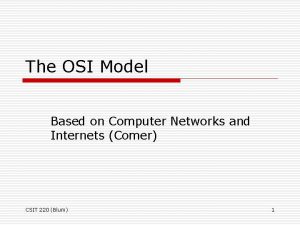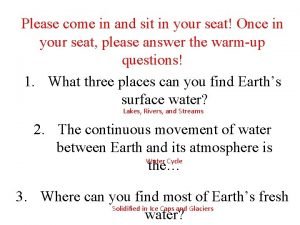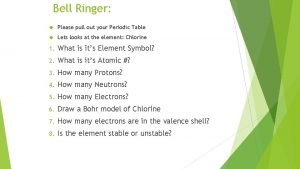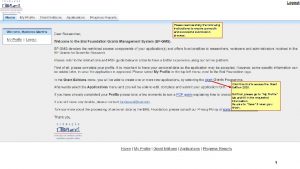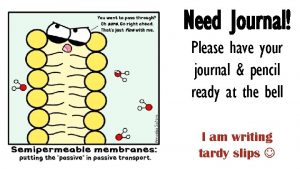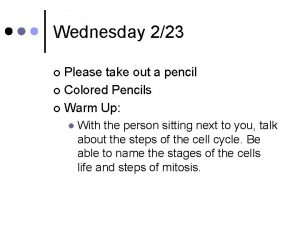Please Take out the Following Pencil Science Journal
















- Slides: 16

Please Take out the Following Pencil Science Journal Agendas Macromolecules Worksheet (Pass it forward if you have not done so already). Plan for the week Copyright ©The Mc. Graw-Hill Companies, Inc. Permission required for reproduction or display

Science Question of the Day Explain why the chemical bonds in the body do not break down, spontaneously, releasing all of their energy. Copyright ©The Mc. Graw-Hill Companies, Inc. Permission required for reproduction or display

5. 3 Chemical Reactions Chemical reactions begin with reactants (substrates) which are converted to products Exergonic reactions Products contain less energy than the reactants Endergonic reactions Products contain more energy than the reactants Copyright ©The Mc. Graw-Hill Companies, Inc. Permission required for reproduction or display

Fig. 5. 4 Energy of Activation Extra energy required to destabilize chemical bonds and so initiate a chemical reaction Copyright ©The Mc. Graw-Hill Companies, Inc. Permission required for reproduction or display

Fig. 5. 4 Catalysts lower the activation energy of a reaction, and thus increase its rate However, they cannot make an endergonic reaction exergonic Copyright ©The Mc. Graw-Hill Companies, Inc. Permission required for reproduction or display

5. 4 How Enzymes Work Enzymes are proteins that serve as catalysts They speed up chemical reactions within cells Enzymes bind a specific molecule and stress bonds to make a particular reaction more likely Active site Site on enzyme surface where reactant fits Binding site Site on reactant where enzyme binds Copyright ©The Mc. Graw-Hill Companies, Inc. Permission required for reproduction or display

Fig. 5. 5 Enzyme shapes determines its activity Changes upon binding of the substrate The substrate is now bound more intimately Lysozyme Copyright ©The Mc. Graw-Hill Companies, Inc. Permission required for reproduction or display

Fig. 5. 6 How enzymes work Copyright ©The Mc. Graw-Hill Companies, Inc. Permission required for reproduction or display

Fig. 5. 7 The catalytic cycle of an enzyme 1 The substrate, sucrose, consists Glucose Fructose of glucose and fructose bonded together. 2 The substrate binds to the enzyme, forming an enzymesubstrate complex. Bond 4 Products are H 2 O released, and the enzyme is free to bind other substrates. Active site Enzyme 3 The binding of the substrate and enzyme places stress on the glucose-fructose bond, and the bond breaks. Copyright ©The Mc. Graw-Hill Companies, Inc. Permission required for reproduction or display

5. 5 Factors Affecting Enzyme Activity Enzyme activity is affected by any change in condition that alters the enzyme’s 3 -D shape The structural bonds of enzymes are sensitive to changes in temperature and p. H Therefore, a temperature or p. H beyond the optimal range will cause the enzyme to denature Copyright ©The Mc. Graw-Hill Companies, Inc. Permission required for reproduction or display

Enzyme Activity Copyright ©The Mc. Graw-Hill Companies, Inc. Permission required for reproduction or display

Fig. 5. 8 Enzymes are sensitive to their environment Digests proteins in the stomach Digests proteins in the intestine Copyright ©The Mc. Graw-Hill Companies, Inc. Permission required for reproduction or display

5. 6 How Cells Regulate Enzymes A cell can control the activity of an enzyme by altering its shape Allosteric enzymes have shapes that can be altered by the binding of signal molecules These molecules bind to the allosteric site Repressors bind and repress enzyme activity Activators bind and restore or increase enzyme activity Copyright ©The Mc. Graw-Hill Companies, Inc. Permission required for reproduction or display

Fig. 5. 9 How cells control enzymes Copyright ©The Mc. Graw-Hill Companies, Inc. Permission required for reproduction or display

Enzyme inhibition occurs in two ways: Competitive inhibition - Inhibitor binds at the enzyme’s active site Noncompetitive inhibition - Inhibitor binds at the enzyme’s allosteric site Fig. 5. 10 Copyright ©The Mc. Graw-Hill Companies, Inc. Permission required for reproduction or display

Enzymes Reviewed Copyright ©The Mc. Graw-Hill Companies, Inc. Permission required for reproduction or display
 Please take out some time
Please take out some time Please miss once
Please miss once Metaphor in one thing one direction
Metaphor in one thing one direction How many people does it take to make a pencil
How many people does it take to make a pencil Will you please be quiet please raymond carver
Will you please be quiet please raymond carver Poetrywithpassion
Poetrywithpassion Welcome please take a seat
Welcome please take a seat Please do not throw away sausage pizza
Please do not throw away sausage pizza Sit on your seat
Sit on your seat Please take a seat
Please take a seat Take prepositional phrase
Take prepositional phrase Oedipus the king notes
Oedipus the king notes My favourite is science
My favourite is science Take a bus or take a train
Take a bus or take a train Periodic table bell ringer
Periodic table bell ringer Please read the carefully before you fill out the form
Please read the carefully before you fill out the form Take out your notebook
Take out your notebook







